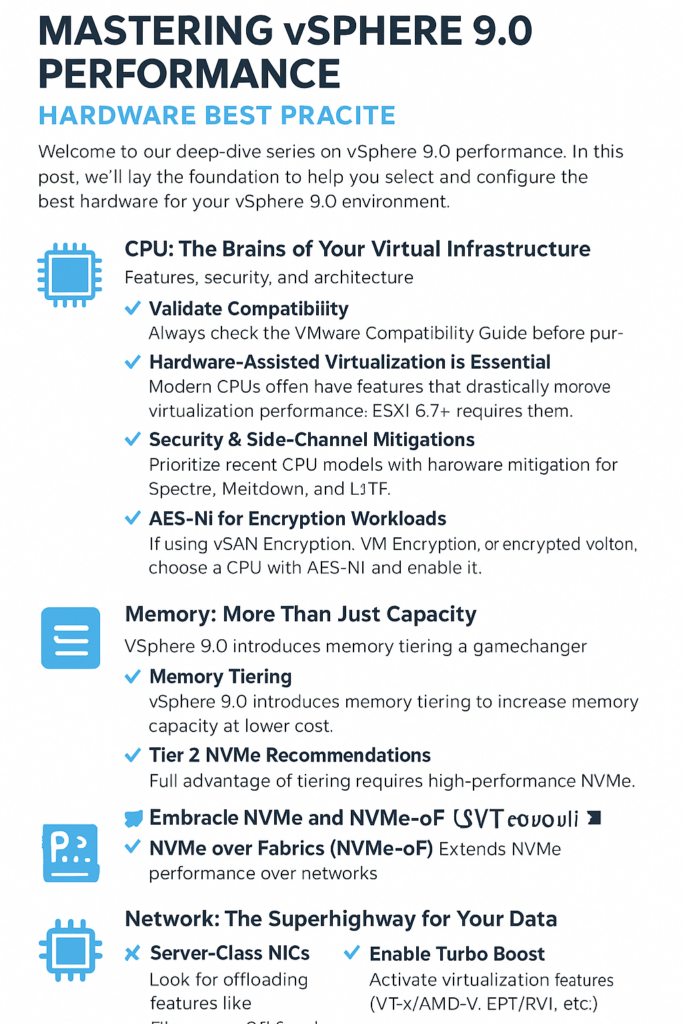
Welcome to our deep-dive series on vSphere 9.0 performance. Whether you’re designing a new environment or refreshing hardware, the decisions you make at the physical layer will echo through your entire virtual infrastructure.
✅ Right choices = solid, high-performing foundation
⚠️ Wrong choices = years of performance headaches

Let’s break down the key hardware considerations to get your environment firing on all cylinders.
🧠 CPU: The Brains of Your Virtual Infrastructure
The CPU isn’t just about clock speed anymore—it’s about features, security, and architecture.
Key Steps for CPU Selection
1. Validate Compatibility
🔹 Always check the VMware Compatibility Guide before purchasing.
🔹 Unsupported CPUs = trouble.
2. Hardware-Assisted Virtualization is Essential
Modern CPUs offer performance-boosting features. ESXi 6.7+ requires:
-
CPU Virtualization (Intel VT-x / AMD-V): Enables efficient virtualization
-
MMU Virtualization (Intel EPT / AMD RVI): Reduces memory overhead
-
I/O MMU Virtualization (Intel VT-d / AMD-Vi): Needed for DirectPath I/O & SR-IOV
3. Security & Side-Channel Mitigations
-
Prioritize recent CPU models with hardware mitigations for Spectre, Meltdown, and L1TF
-
Performance impact is minimal compared to older CPUs relying on software fixes
4. AES-NI for Encryption Workloads
If using vSAN Encryption, VM Encryption, or encrypted vMotion:
-
Choose a CPU with AES-NI
-
Enable it in BIOS to offload encryption from CPU
💾 Memory: More Than Just Capacity
Memory is the lifeblood of your environment. vSphere 9.0 introduces memory tiering, making it easier to scale efficiently.
Memory Tiering Highlights
-
Fast DRAM: Top-tier cache
-
NVMe storage: Second-tier, cost-efficient memory
Tier 2 NVMe Recommendations
-
≥ 100,000 IOPS
-
≥ 3 DWPD endurance
-
Adequate capacity for workload needs
⚡ Tip: High-quality NVMe ensures memory tiering delivers real performance gains.
🚀 Storage: Where Performance is Made or Broken
Slow storage kills application performance. Build it right from day one.
Best Practices
1. Use VAAI (vStorage APIs for Array Integration)
-
Offloads cloning, zeroing, and locking to the storage array
-
Speeds up Storage vMotion and VM deployment
-
Reduces CPU load
2. Embrace NVMe and NVMe-oF
-
Local NVMe: PCIe flash cards for ultimate performance
-
NVMe over Fabrics (NVMe-oF): Extends NVMe performance over networks
-
For NVMe over TCP/IP, enable jumbo frames
-
💡 Pro Tip: NVMe-oF can deliver higher IOPS and lower latency than traditional remote storage.
🌐 Network: The Superhighway for Your Data
A fast network prevents bottlenecks and ensures smooth VM operation.
Network Recommendations
-
Server-Class NICs: Look for offloading features like Checksum Offload, TSO, LRO
-
Plan Bandwidth Carefully: PCIe slot placement matters—40Gb NIC in a slow slot = wasted potential
-
Consider DPUs (SmartNICs): Offload networking & security from the host CPU to free up resources
⚙️ BIOS Settings: The Final Polish
Default BIOS settings are rarely optimized for virtualization. Spend 5–10 minutes tweaking these:
-
Enable all cores and sockets
-
Turn on Hyper-Threading
-
Enable Turbo Boost
-
Activate virtualization features (VT-x/AMD-V, EPT/RVI, etc.)
-
Set Power Management to “OS Controlled” – let ESXi manage P-states & C-states
💡 Insider Tip: The “Balanced” policy in ESXi often gives best performance and power efficiency.
✅ Key Takeaways
-
CPU: Pick modern, compatible CPUs with hardware virtualization and AES-NI
-
Memory: Leverage vSphere 9.0 memory tiering with high-performance NVMe
-
Storage: Use VAAI and NVMe/NVMe-oF for lightning-fast performance
-
Network: Invest in server-class NICs and consider SmartNICs
-
BIOS: Optimize core settings for virtualization and OS-controlled power
By laying the right hardware foundation, your vSphere 9.0 environment will run smoothly, securely, and efficiently for years to come.


